Carl W.
Active Member
 Administrator
The Golden Lions
Administrator
The Golden Lions
Posts: 265
|
Post by Carl W. on Jun 27, 2009 15:54:49 GMT -5
Inspired by Floyd's suggestion, here are a few tips on how to 'read' a WWII service uniform so to speak. INSIGNIA AND DECORATIONSWearing of regulation cloth insignia on the enlisted man’s service uniform (overcoat, service coat, IKE jacket, wool or cotton shirt)  1.Service stripes AKA “Hash Marks” 1.Service stripes AKA “Hash Marks”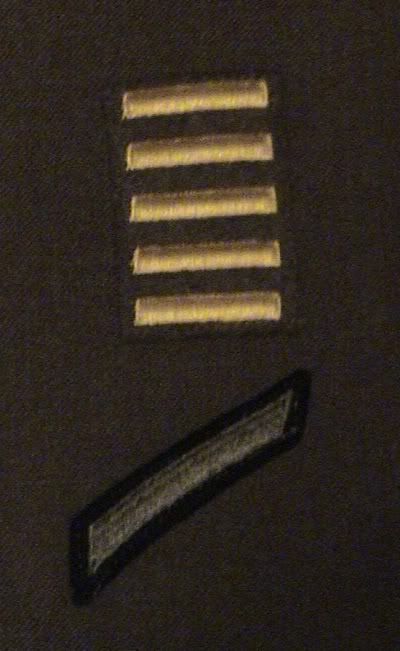 Enlisted men were authorized to wear a service stripe for each 3-year period of service. This was positioned on the left sleeve of the service coat or IKE jacket (sometimes on the shirt), the lower edge being 4 inches from the bottom of the sleeve. 2.Meritious Service Unit Badge The Meritious Service Unit Plaque was established in August 1944 to reward the efficiency of Army Service Forces units. Their personnel was allowed to wear the badge on the right sleeve of the service coat or IKE jacket or the sleeve of the shirt when it was worn as an outer garment. 3.Overseas Service Bars AKA “Hershey Bars”One bar for each period of 6 moths overseas, worn on the lower left sleeve of the service uniform.
4.Honorable Discharge Insignia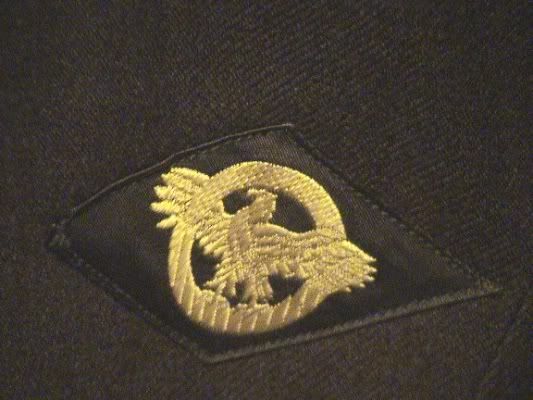 In order to distinguish a soldier on pass (still under military law) from a discharged serviceman returning home in uniform, the latter wore this honorable discharge insignia, better known as “the ruptured duck” on the left breast of the overcoat, jacket or shirt.
PLACEMENT ON THE UNIFORM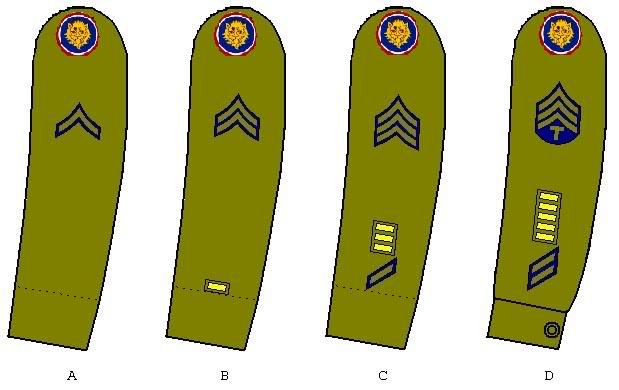 A: PFC, less than three years of service; less than six months overseas service B: CPL, less than three years of service, between 6 and 12 months overseas service C: SGT, over three years of service, between 18 and 24 months overseas service D: T/4, over six years of service, between 30 and 36 months overseas service ![]() www.usmilitariaforum.com/uploads//post-83-1168103512.jpg[/IMG] www.usmilitariaforum.com/uploads//post-83-1168103512.jpg[/IMG]![]() www.usmilitariaforum.com/uploads//post-83-1168103529.jpg[/IMG] www.usmilitariaforum.com/uploads//post-83-1168103529.jpg[/IMG] |
|
Carl W.
Active Member
 Administrator
The Golden Lions
Administrator
The Golden Lions
Posts: 265
|
Post by Carl W. on Jun 27, 2009 15:58:30 GMT -5
GARISSON CAP PIPING CHARTEach branch of service within the US Army had its distinctive color. The soldier's garisson cap would have a bread or piping which indicated his branch of service.  
|
|
Carl W.
Active Member
 Administrator
The Golden Lions
Administrator
The Golden Lions
Posts: 265
|
Post by Carl W. on Sept 22, 2009 10:51:07 GMT -5
Carl So.....educate me about left and right shoulder patches??? I was aware that combat patches are "subdued" and non-combat are in full color (I think I am correct on that), but was not aware that the shoulder on which the patch is worn is different depending on combat/non-combat status. Maybe this thread should be elsewhere, just move it and I will find it.  Thanks....Roger Roger Roger During WWII all shoulder patches were in full color. The 89th and 92nd Infantry division patches of WWII vintage are commonly mistaken for subdued patches. During WWII, no division had or wore a subdued patch. The use of subdued patches is a postwar invention. Now for the issue of placement of the patches: A GI of the 106th Infantry Division would wear the Golden lion patch on his left shoulder. The left shoulder patch is designated as the combat patch meaning that this is the soldiers unit in which he is currently serving. If for instance that soldier would be transferred to another division, he would wear the patch of that division on his left shoulder. Now, on July 18, 1945 a directive was given out allowing soldiers to wear patches on both arms. Many soldiers would transfer to other units to gather points that were necessary to be discharged from the army. As soldiers are proud of their unit some were having issues with having to change patches. Therefor the Army allowed soldiers to sew on the patch of their old outfit on the right shoulder and the one of their new outfit on the left shoulder. I believe this is still in use today. In cases where a soldier was assigned to more than one unit in the past, he was authorized to sew on the patch of the outfit of his choice. Hope this clears it up ;-) Carl |
|
|
|
Post by floydragsdale on Sept 22, 2009 13:30:16 GMT -5
I have 3 (three) short gold hash marks on my Ike Jacket right sleeve; they represent 18 months of overseas duty (three months overseas dury = 1 (one) hash mark.
Floyd,
424th Regiment
|
|
roger
Active Member

Posts: 134 
|
Post by roger on Sept 23, 2009 11:36:04 GMT -5
Carl and Floyd
Thanks, guys.....I understand now and it is consistant with my dad's Ike jacket. I was confused by Carl's reference to "combat".....it just meant it was the current unit of assignment. Dad's jacket also has 3 gold hash marks for his overseas duty and 1 long green one.
Roger
|
|
|
|
Post by floydragsdale on Sept 27, 2009 20:33:06 GMT -5
Hello:
We ( WWII G.I's) had a name for #4.
It was called the Ruptured Duck! Why, is a mystery to me. I must have taken mine off; it isn't on my Ike Jacket anymore.
To those who may read this! I have been away for the past week & haven't had time to play "catch up".
Floyd
|
|
|
|
Post by bruce gillespie on Dec 25, 2009 11:44:50 GMT -5
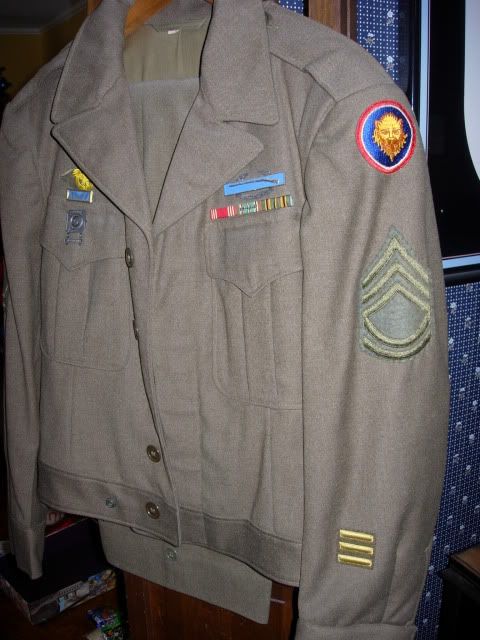 Carl, I need some help. This was my Dads uniform he was in the 424th 106th as a "combat infantryman" according to his discharge papers. I'd like to be able to understand what the uniform says. Somethings on the uniform don't jive with his discharge record. |
|
Carl W.
Active Member
 Administrator
The Golden Lions
Administrator
The Golden Lions
Posts: 265
|
Post by Carl W. on Dec 25, 2009 15:00:37 GMT -5
Hi Bruce,
First of all welcome to the board.
Your father's Ike jacket bears the following:
- Technical Sergeant chevrons
- 3 overseas stripes (aka hash marks) depicting 18 months of overseas service.
- The ruptured Duck insignia over the left pocket, for honorable discharge
- The metal pin on the left pocket appears to be a Driver's Qualification Badge. It should have a specialistation on the little bar, but I can't read it
- The Combat Infantryman's Badge
- Ribbons, Army Good Conduct Medal, European Campaign Medal with three bronze campaign stars (Ardennes-Alsace, Northern France and Rhineland, Central Europe) and the American Campaign Medal for service withing the Continental US between 1941 and 1945.
The little blue ribbon above the left pocket is the "Presidential Unit Citation". I do not have knowledge of any info that says that the 424th (or a unit of the 424th) was awarded a PUC. It could be that these were awarded on an individual basis to the units that were involved with the defense of St Vith. CCB of the 7th Armored was awarded the PUC for actions at St Vith, as well as the 81st Engineers. Other individuals that fought there on Dec 20-21 were also elegible to wear the PUC. That would certainly be interesting to look into. What company was your father in?
Perhaps Floyd knows more of a PUC awarded to the 424th?
What I do know is that the entire Regiment was awarded the Belgian Fourragere (Croix de Guerre) for action at St Vith.
I also notice that your father's Ike jacket is missing the collar discs. There should be one on each lapel, one with US and another with a set of crossed rifles (infantry)
What do you think does not match with the discharge papers?
Greetings and Merry Christmas
Carl
|
|
|
|
Post by sandy on Dec 25, 2009 21:54:45 GMT -5
carl, i just wanted to see what the Belgian Fourragere looked like that you spoke of.
thanks,sandy
|
|
Carl W.
Active Member
 Administrator
The Golden Lions
Administrator
The Golden Lions
Posts: 265
|
Post by Carl W. on Dec 26, 2009 6:04:15 GMT -5
Here's a picture of the Belgian Fourragere 1940. It is a shouldercord that goes on the left shoulder of the uniform. It was created by Decree N°300 of March 26, 1945 – by Prince Charles, Regent of the Kingdom of Belgium, and upon the proposal of the Minister for National Defense . It is important to note that, besides being created for issue to the Belgian Armed Forces for acts of bravery during WWII, this ‘special badge’ was to be conferred on those units who counted at least TWO CITATIONS in the Order of the Day of the Belgian Army. For the 424th Infantry Regiment: Cited in the ORDER OF THE DAY of the Belgian Army for action in the ARDENNES (424th Infantry cited per DA GO 43, 1950). Cited in the ORDER OF THE DAY of the Belgian Army for action at ST VITH (424th Infantry cited per DA GO 43, 1950).  On the uniform of 1st Sgt Harold Jensen of the 424th, that I have in my collection, there is also a fourragere which appears to be the French Fourragere (more greenish). As many of these fourrageres look alike they are commonly mistaken for another. I'm still looking for more info on this award. Hope this helps Carl |
|
|
|
Post by bruce gillespie on Dec 28, 2009 19:41:40 GMT -5
 Carl, I hope it's ok to post this. If not please take it down. Here goes, Well they got his name right. Grade says T/4. Isn't it different on the uniform? Length of service 29 1/4 months. Sleeve bars say 3 years. Dates say 3 years 8 months. It says he was discharged from Pine Camp (Fort Drum). Sounds like everyone else in the 424th was discharged from somewhere else in NY. under "Occupations" It says 166th Division but I'm figuring it's just a typo. I'll post a couple of pics, you'll see him sitting on the hood of a truck and the bumper says 106th 424th. I have nothing thats says he was in IN. for basic with everyone else in the 424th. Everything looks like he was in Ft. Benning. Could this be right? One other thing - if you could tell me what the from number is on this form it would be a great help. I'm looking for a dd-214 and I can't read the form number on this form. All I have is a copy. Thanks again for all your help. |
|
|
|
Post by bruce gillespie on Dec 28, 2009 19:55:36 GMT -5
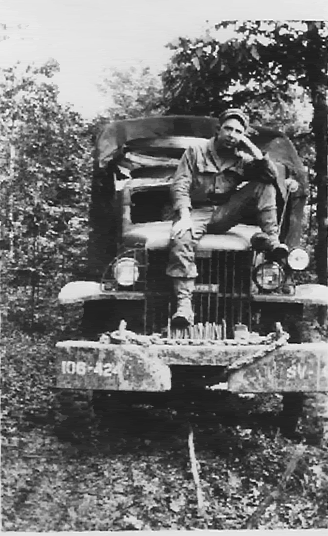 Dad sitting on a 6x6, but I don't know if the picture was taken in the states or in Europe. Carl, Going back to the previous post. I know we have the collar disks. I can't find them right this min. I don't think I've ever seen the "Belgian Fourragere" It doesn't seem like something you lose. I know he was in St. Vith, I'd heard him talk about it many times. |
|
Carl W.
Active Member
 Administrator
The Golden Lions
Administrator
The Golden Lions
Posts: 265
|
Post by Carl W. on Dec 29, 2009 14:35:09 GMT -5
Hi Bruce, As stated in my previous post in the other topic, I'm pretty sure that your dad was in Service Company of the 424th. Note the "SV" marking on the fender of the truck. This photo is definitely taken in the US, probably during maneuvers in early 1944. The uniform (HBT fatigues) and leggings and field shoes point that out. As for the Fourragere. Bear in mind that it was not awarded by the Belgian government until 1950, 5 years after the war had ended. I think that most former-GI's had other things on their minds then and many must have never been informed about the decoration. Other uniforms of 424th members I have seen also didn't have the fourragere. Also, sometimes GI's took "artistic freedom" with their uniforms. I have seen pictures of officer's shirts being worn by enlisted men, combat stars on ribbons that don't need to have them, anything is possible. Same goes for the 'hash marks'. Your dad did have the correct number of bars on his jacket. The golden bars are for overseas service, i.e. serice in the ETO or any other theatre of operations. The bars for army service are the green bars in the top post. They are not on the Ike jacket but your dad was entitled to wear one (each one is for 3 years of service). The gold bars are for a total of 18 months of service in Europe. The mismatching rank however is unusual, but not impossible. In the picture taken overseas your father seems to be wearing the T/4 rank on his field jacket? T/4 stands for "Technical Sergeant 4th grade" and the "T" meant that the soldier in question had a specialized service (such as a driver, radio technician etc). The chevrons on your dad's Ike jacket are of a Technical Sergeant (2nd grade). I could be mistaken but I was also under the impression that a soldier would get a rank promotion upon discharge. Anyone have any further info on this? Floyd, I wonder if you have the fourragere on your Ike jacket and were aware of that decoration being awarded to the 424th?Bruce, the form you posted is not the DD-214. The DD-214 contains more detailed info. See this example:  If you do not have this form in your posession you could try the National Archives in St Louis or the County Recorder's office from the county your father lived in when he was discharged. They normally have a copy of the DD-214. Another option is the VA. Hope this helps! Carl |
|
|
|
Post by bruce gillespie on Dec 29, 2009 20:14:08 GMT -5
Wow Carl, Your unbelievable. Thanks for all your help. I'll be back.
|
|
daryl
Active Member

Posts: 25
|
Post by daryl on Apr 13, 2010 0:21:59 GMT -5
Although my dads uniform no longer exists, the photo shows the medals and bars that we have. I know the purple heart, dog tags including the POW tag and the I.D. bracelet. However, I do not know what the others are for. Can you tell me? I may be mistaken but I seem to remember as a child, looking at these items, stored in his purple heart box in his dresser drawer and seeing 1 or 2 other bars that were about three times longer than the 4 shown. But I could be mistaken. Also shown in the 2nd picture is the dog tag that was lost in Belgium and purchased by me off ebay after it was found a few years ago. I notice that this dog tag is differant than the two shown in the 1st photo. What is the differance? P.S. The second picture is in the next post. I quess you can't post 2 pics on a post. Attachments:
|
|
daryl
Active Member

Posts: 25
|
Post by daryl on Apr 13, 2010 0:27:22 GMT -5
This is the second picture... Attachments:
|
|
|
|
Post by gfgrant8443 on Apr 13, 2010 7:56:55 GMT -5
Daryl
The dog tag in the picture with the name and address on it looks like one your dad had made by one of the many shops that you find around any military base in the US. It is the first tag that I have ever seen with that much informaton on it. I'm guessing he must have discarded it when he was captured so the German Army wouldn't have made use of the information. I may be all wet on this, but that my impression.
Regards,
Frank Grant
|
|
|
|
Post by floydragsdale on Apr 13, 2010 11:29:50 GMT -5
Hello Frank:
I was thiking the same thing as you were.
To my knowledge all dog tags issued by the Army had a soldiers name, serial number, blood type and religious preferance stamped on them.
The tags you refer to were more than likely discarded by the soldier to keep them out of "enemy" hands.
Floyd
424th Regiment
|
|
|
|
Post by gfgrant8443 on Apr 13, 2010 16:56:59 GMT -5
Hello Floyd
I can recall reading somewhere that if the Nazi's were able to get a POW's home address, etc. they would contact the family and ask for money to make life easier for their son or husband. I don't recall the author of the book I read that in. but I can certainly see it as an incentive to stick to name, rank and service number. If anyone else has heard that please let me know the source so I can look it back up.
Thanks
Frank Grant
|
|
daryl
Active Member

Posts: 25
|
Post by daryl on Apr 14, 2010 5:06:36 GMT -5
I did some Googleing and found this site... www.hardscrabblefarm.com/ww2/dogtags_serial.htmIt shows that the tags with the address and next of kin were standard from Dec. 1940-July 1943 after which they went to the more commonly seen type without the address and next of kin. So the tag which he lost in the Bulge in Dec 1944, with the address, was no longer issued after July 1943, a full years and a half before he went over seas. But the tags he brought home were issued beginning March 1944, 8 months before he went overseas. So, did he wear both sets to war in Dec 1944, throwing away the one with the address and keeping the other? Or did he take just the one with the address, loose it and then get a reissued tag after he got freed from POW? When the addressed tag was no longer being issued, was it required to turn it in and get the newly issued tag or was it ok to just keep the old tag. Sorry for rambling. Just find this very interesting. |
|
Carl W.
Active Member
 Administrator
The Golden Lions
Administrator
The Golden Lions
Posts: 265
|
Post by Carl W. on Apr 18, 2010 13:20:34 GMT -5
Hi Daryl,
About the dogtags:
As you stated in your last post, the dog tag of your father that was found in the Ardennes and eventually found it's way home was the standard type issued in the early days of the war. Note that the early tag did not show your father's tetanus innoculation from 1944, only the one from 1943 (probably at time of enlistment) T43. When the new type of tag came into service, soldiers were issued with a new set. I assume they were allowed to keep the old set because I have seen these in many veteran's posessions, usually with a set of the second type if they enlisted around or before 1943. The old type, with the next of kin info was suspended on a link chain, which was prone to breaking. The newer type came with the well known 'bead' style chain, which is still in use today with armies around the world.
My guess is he wore (one of, or) both sets and upon capture decided to get rid of the one with the next of kin address. This could have been done for various reasons. Another option is indeed, as you say, that he was issued a new set after being liberated from the POW camp.
I have a small group from a POW of the 422nd who wore one tag with the next of kin info (old style) and another of the newer 1944 type.
The rest of the items and ribbons on the picture you posted are:
An Army Good Conduct medal and ribbon: the red one with white stripes.
Two American Campaign ribbons (the blue ones)\
A WWII victory ribbon and lapel pins for the PH, GCM and the ruptured duck (honorable discharge) insignia to be worn on civilian clothing.
The longer bars you saw when you were young were probably the identical ribbons mounted on a ribbon bar slide to hold the various ribbons together. Your dad probably had multiple sets for his various uniforms.
Greetings
Carl
|
|
daryl
Active Member

Posts: 25
|
Post by daryl on Apr 19, 2010 15:39:13 GMT -5
As I said before, thank you all for all your help.
O my gosh. When I read "bar slide" I had an immediate flash in my head. Thats funny because I never knew about a bar slide and I hadn't even finished the sentence when I pictured the image in my head. If anyone has a picture of a "bar slide" please post it so I can see if my brain flash was for real. Thats funny!
|
|
Carl W.
Active Member
 Administrator
The Golden Lions
Administrator
The Golden Lions
Posts: 265
|
Post by Carl W. on Apr 21, 2010 14:50:05 GMT -5
As I said before, thank you all for all your help. O my gosh. When I read "bar slide" I had an immediate flash in my head. Thats funny because I never knew about a bar slide and I hadn't even finished the sentence when I pictured the image in my head. If anyone has a picture of a "bar slide" please post it so I can see if my brain flash was for real. Thats funny! Daryl, It looks like this. It's a metal mount with a pin or clutch fastener on the back which can hold up to three ribbons.  Greetings Carl |
|
|
|
Post by bruce gillespie on Dec 17, 2010 20:43:49 GMT -5
Hello all .........It's been a while but I've found it - I think? Carl, Is this the infamous DD-214? (no help from uncle S) we just found it with a bunch of old papers. also found abunch of other stuff. I'll post it over the next few days. 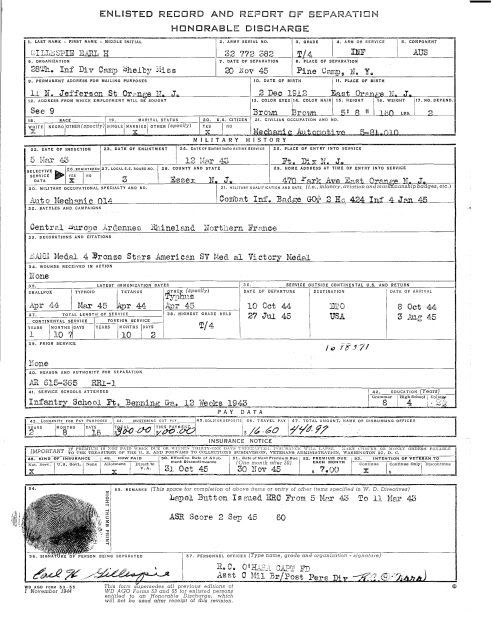 |
|
Carl W.
Active Member
 Administrator
The Golden Lions
Administrator
The Golden Lions
Posts: 265
|
Post by Carl W. on Dec 18, 2010 12:40:23 GMT -5
Hi Bruce
That's the one! Interesting to see that your father was with the 28th "Bloody bucket" division at the time of his discharge. He was probably transferred from the 106th to the 28th somewhere in 1945 because he had too few 'points'.
Looking forward to the rest.
Greetings from snowy Belgium!
Carl
|
|
|
|
Post by bruce gillespie on Dec 19, 2010 8:47:10 GMT -5
Carl, How do I find out when and where he was transferred? I didn't understand the other division when I looked at it. I read somewhere that the 424th and 28th were together in the Bulge. True? Here are some of the missing uniform items - but I need help to ID some of them. 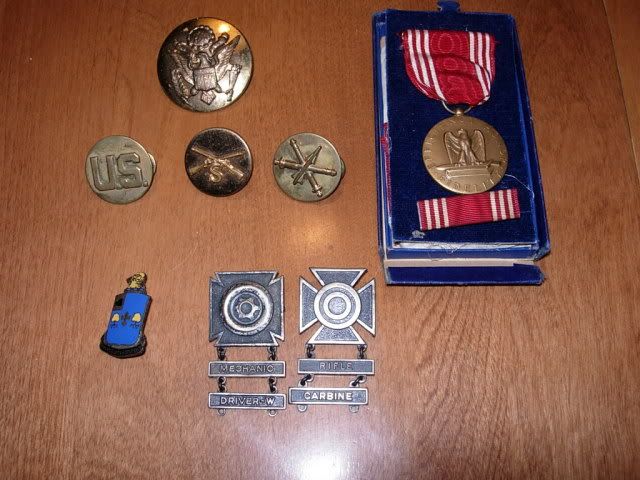 |
|
|
|
Post by bruce gillespie on Dec 19, 2010 9:00:03 GMT -5
I've also found a few pictures, I'm not sure who most of these people are, but I'd like to post them and see if anyone can help me put a name to the face.
Where would you like me to put them?
Note: I also have a few newspaper articles I'd like to post, should I put them in the same place as the pictures?
|
|
Carl W.
Active Member
 Administrator
The Golden Lions
Administrator
The Golden Lions
Posts: 265
|
Post by Carl W. on Dec 19, 2010 14:06:32 GMT -5
Hi Bruce. The big brass round badge is a cap device for the enlisted man's peaked cap. The collar discs are worn on the lapels of the Class A uniform: I see the standard US disc, a infantry disc with "S", which some claim was issued to sharpshooters. The other one is for the branch of Air Defense Artillery. The blue device is a distinctive unit insignia (unit crest). Any idea what slogan is mantioned on it, that could help with the identification. The 106th did not have similar crests as they had not been designed before 1945 and approved by the Institute of heraldry.
The two badges are Army qualifiation badges. The left one is the Motor Vehicle Badge. The Badge is awarded to enlisted soldiers who have received training, and subsequent qualification, to operate or repair military motor vehicles. The "driver-W" means your dad was qualified to drive wheeled vehicles.
The other badge is the sharpshooter badge. This indicates that your dad scored well with carbine and M1 rifle on the firing range.
The boxed medal is the Army Good Conduct Medal.
A suggestion: You can post the pictures under "looking for comrades" and perhaps the articles under 'for the record" ?
Greetings from Belgium
Carl
|
|
|
|
Post by bruce gillespie on Dec 19, 2010 18:08:24 GMT -5
Thanks Carl, You are just a wealth of knowledge. I did find the cap as well. I'll post a picture of it when I get a chance.
The unit crest says "Dune Vaillance Admirable" on the bottom.
|
|
|
|
Post by connie on Apr 26, 2011 1:36:46 GMT -5
While the 106th division was at Camp Atterbury over 7,000 men were taken from the division to fill manpower needs of other divisions. The division, in turn, waited for its own replacements. This means that a lot of the pre- ETO photos of soldiers who eventually fought with the division. These early photos show them before their days with the 106th wearing the shoulder patches of other divisions. Likewise some stayed on in the ETO after the division had left. So there may some post VE day photos of men from the 106th who moved on to other units. I went web surfing trying to find a site that could help identify these shoulder patches. The one I found is a site that sells these patches. But it looks to me to be pretty complete. Here's what I found: www.wardogmilitaria.com/index.php?main_page=index&cPath=34 |
|





![]() www.usmilitariaforum.com/uploads//post-83-1168103512.jpg[/IMG]
www.usmilitariaforum.com/uploads//post-83-1168103512.jpg[/IMG]![]() www.usmilitariaforum.com/uploads//post-83-1168103529.jpg[/IMG]
www.usmilitariaforum.com/uploads//post-83-1168103529.jpg[/IMG]



















